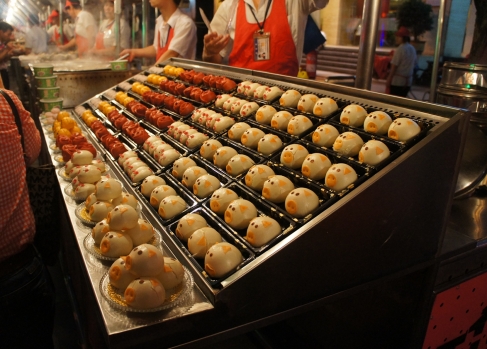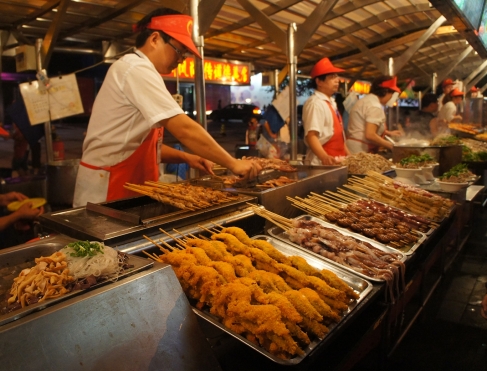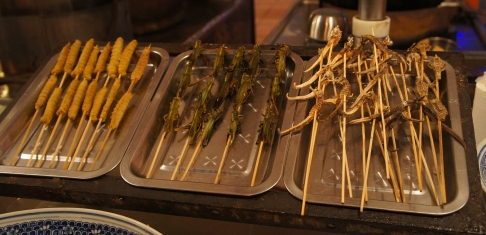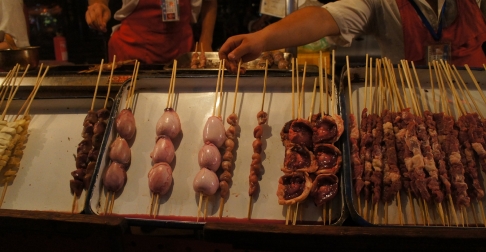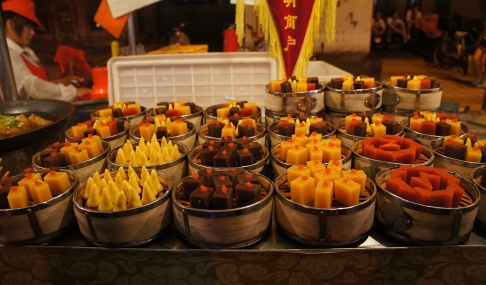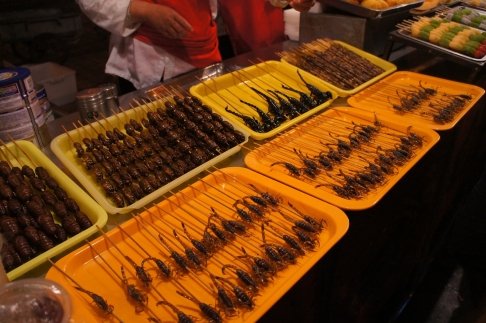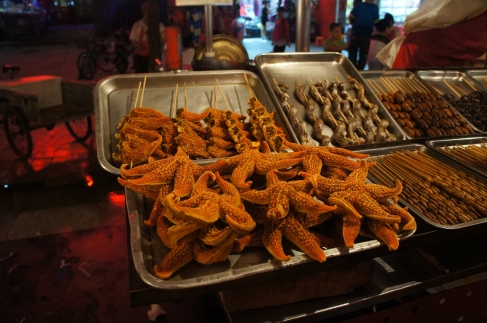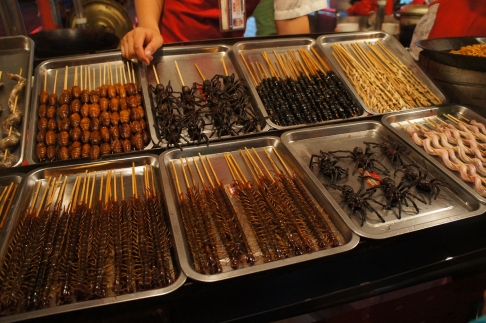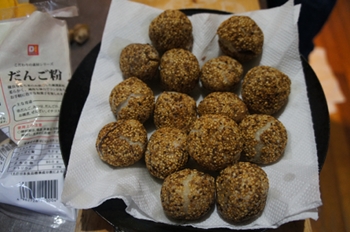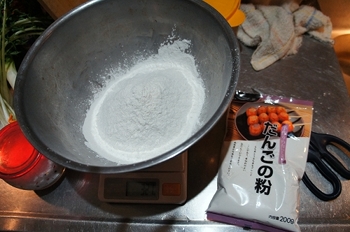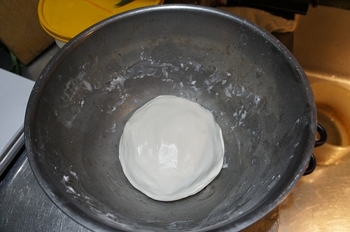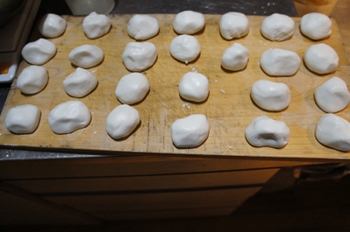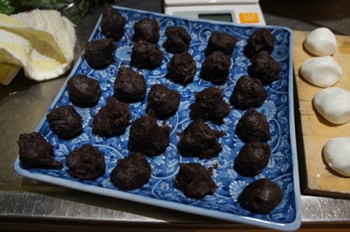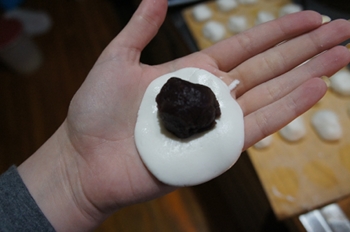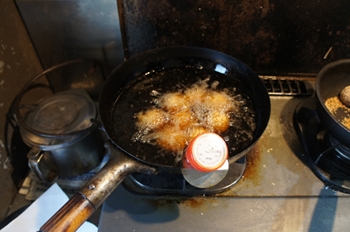Just felt like sharing some of the photos I took at the night food market in Beijing. Please note that most of the pictures are not the weak stomachs – lot of bug pictures.
Category Archives: Food
Recipe: Making Goma Dango (Sesame Dumplings) [ごま団子]
So like a big amount of girls I love sweets and it’s a miracle that I’m not bigger than I am – since I seem to spend a good part of time eating anything from cakes, cookies and sweet bread – especially when I’m in Japan. One of my favorites here in Japan is pretty much anything with “anko” (red bean paste) and the price winner among anko desserts are “goma dangos” (sesame dumplings). In Japanese these dumplings are considered “chuka” – food which originates from China, but like with most so-called Chinese food in Japan, I feel sure that the taste is different from whatever they might have been inspired from. Anyways, I made these dumplings twice lately and since they’re very easy to make (if you’re able to get hold of the ingredients) I thought I would share this simple recipe.
These are the needed ingredients:
[For 16 dumplings]
-
200g Dango/dumpling mix.
-
150 ml. water
-
200g Koshian (anko) (Red bean paste)
-
White sesame
-
Frying oil.
First pour the dingo/dumpling mix in a bowl and there after add water (some also add milk) – it’s best to pour it in little at the time to make sure you don’t put too much in. Some dango mix needs more water than other, but when the powder has a firm texture it’s done. Then blend the powder and water together with your hands till it has the wanted texture. You can also add some sugar in the mixture after your own liking.
Then you divide the dango mass into 16 balls. (Yes, there’s more than 16 balls in the picture, but it was for a bigger portion.)
Then your pour out 200g of red bean paste and like with the dumplings you divide the red bean paste into 16 balls.
Then you flat out your small dumpling balls in your hand and place the red bean paste in the middle and then your wrap the dumpling around the bean paste and finally you roll them around in your hand till they reach the wanted round ball shape.
Then you cover the dumplings with the white sesame and then you fry them in oil till they have the good golden color and the outside of the dumpling has hardened a bit and then you’re done!. Enjoy your sesame dumplings.
Youtube: Day 1 – Bangkok
Overall I have been too busy to update my blog during this travel so far, also because I’m working on my youtube channel at the same time. So I thought I would put my youtube updates on this blog as well.
So here’s a video of how my first day in Bangkok – with my husband went. The spoken parts are in Japanese with English (and Japanese) subtitles.
The video contains us getting a bit lost in Bangkok, then we go temple watching and finish the day off at a restaurant.
Tokyo, tourists and earthquakes.
So today is my 3rd day in Tokyo and one thing I cannot complain about is the lack of earthquakes – caused by the aftershocks in the Tohoku area – mostly located in Fukushima. We’ve had two noticeable earthquakes in the past two days. The last one woke us up around 03:50 am with it’s shaking.
There is also several posters everywhere advising people to save electricity.
But, besides that, foreigners seem to have returned to Japan. When I went to Japan back in March I was the only foreigner on the plane surrounded by Japan and didn’t spot a single foreign looking person in Narita airport – even though it was the popular cherry blossom season. Without a doubt the effect of the great Tohoku earthquake and the problems with the Fukushima nuclear power plant. This time around, half of the airplanes passengers were foreigners – even a lot from my own small country; Denmark and also Narita airport showed an increase in foreign tourists, the same with the streets of Tokyo where a foreigner now don’t have to feel “lonely” in the crowds.
So far we have not been doing much, mostly just wandered the streets of Shinjuku where our apartment is located. Yesterday we decided to make “しゃぶしゃぶ (Syabu Syabu)” for dinner.

Japanese Sweets.
The thing I didn’t know I missed.
So I’ve been in Japan almost two days now.
And on the flight I realized that I’ve missed drinking cold green tea and I didn’t even know it.
I actually used to really dislike green tea and avoided drinking it at any cost. Then when I went to Japan last spring, everywhere I went, they offered me green tea. Breakfast, lunch, dinner and all other times. So I started drinking it because there was nothing else and that became normal for me.
So when I was on the flight to Japan I figured, okay why not have some cold green tea and after taking a sip I realized that I had grown really fond of the taste. Guess it just took some time to get used to. So the first thing I bought in the airport in Tokyo, besides two books was a bottle of green tea. Guess I have to enjoy it while time still are.
– I still prefer cold green tea over hot green tea though, but it’s probably also because I overall prefer cold drinks over warm.
カツ丼 (Katsudon)…
Yesterday we had Katsudon, which consists of pork, onions, eggs on top of rice. Katsudon is probably one of my favorite dishes out there. It’s of course not easy to make, with a serious lack of the “right” Japanese ingredients. Which the problem we always seem to face, whenever we feel like eating Japanese food.
We used a Japanese recipe, but…
English Recipe (From: About.com)
Ingredients:
- 3 1/2 cup steamed Japanese rice
- 4 pieces tonkatsu
- 1 onion
- 1 1/4cup dashi soup stock
- 5 tbsp soy sauce
- 2 tbsp mirin
- 1 tbsp sugar
- 4 eggs

